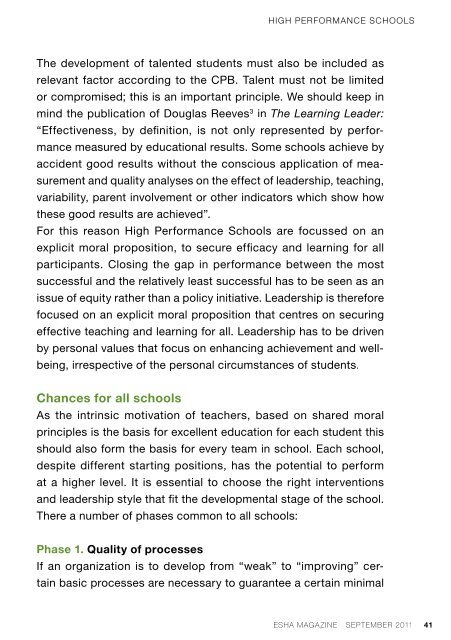Magazine - ESHA
Magazine - ESHA
Magazine - ESHA
You also want an ePaper? Increase the reach of your titles
YUMPU automatically turns print PDFs into web optimized ePapers that Google loves.
The development of talented students must also be included as<br />
relevant factor according to the CPB. Talent must not be limited<br />
or compromised; this is an important principle. We should keep in<br />
mind the publication of Douglas Reeves 3 in The Learning Leader:<br />
“Effectiveness, by defi nition, is not only represented by perfor-<br />
mance measured by educational results. Some schools achieve by<br />
accident good results without the conscious application of mea-<br />
surement and quality analyses on the effect of leadership, teaching,<br />
variability, parent involvement or other indicators which show how<br />
these good results are achieved”.<br />
For this reason High Performance Schools are focussed on an<br />
explicit moral proposition, to secure effi cacy and learning for all<br />
participants. Closing the gap in performance between the most<br />
successful and the relatively least successful has to be seen as an<br />
issue of equity rather than a policy initiative. Leadership is therefore<br />
focused on an explicit moral proposition that centres on securing<br />
effective teaching and learning for all. Leadership has to be driven<br />
by personal values that focus on enhancing achievement and well-<br />
being, irrespective of the personal circumstances of students.<br />
Chances for all schools<br />
As the intrinsic motivation of teachers, based on shared moral<br />
principles is the basis for excellent education for each student this<br />
should also form the basis for every team in school. Each school,<br />
despite different starting positions, has the potential to perform<br />
at a higher level. It is essential to choose the right interventions<br />
and leadership style that fi t the developmental stage of the school.<br />
There a number of phases common to all schools:<br />
Phase 1. Quality of processes<br />
HIGH PERFORMANCE SCHOOLS<br />
If an organization is to develop from “weak” to “improving” cer-<br />
tain basic processes are necessary to guarantee a certain minimal<br />
<strong>ESHA</strong> MAGAZINE SEPTEMBER 2011 41


